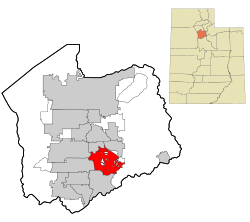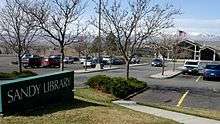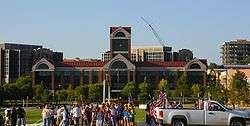Sandy, Utah
| Sandy City, Utah | |
|---|---|
| City | |
|
Sandy city hall | |
 Location in Salt Lake County and the state of Utah. | |
| Coordinates: 40°34′21″N 111°51′35″W / 40.57250°N 111.85972°WCoordinates: 40°34′21″N 111°51′35″W / 40.57250°N 111.85972°W | |
| Country | United States |
| State | Utah |
| County | Salt Lake |
| Founded | 1871 |
| Incorporated | 1893 |
| Government | |
| • Mayor | Tom Dolan |
| Area | |
| • Total | 22.3 sq mi (57.9 km2) |
| • Land | 22.3 sq mi (57.8 km2) |
| • Water | 0.0 sq mi (0.1 km2) |
| Elevation | 4,450 ft (1,356 m) |
| Population (2012) | |
| • Total | 89,344 |
| Time zone | MST (UTC-7) |
| • Summer (DST) | MDT (UTC-6) |
| ZIP codes | 84070, 84090-84094 |
| Area code(s) | 385, 801 |
| FIPS code | 49-67440[1] |
| Website | www.sandy.utah.gov |
Sandy (officially known as Sandy City) is a city in Salt Lake County, Utah, United States. It is a suburb of Salt Lake City. The population was 87,461 at the 2010 census,[2] making it the sixth-largest city in Utah.
Sandy is home to the South Towne Center shopping mall, the Jordan Commons entertainment and dining complex, and the Southtowne Exposition Center. It is also the location of the soccer-specific Rio Tinto Stadium, which hosts Real Salt Lake home games, and opened on October 8, 2008.
History


Located at the base of the Wasatch Mountains thirteen miles (19 km) south of Salt Lake City, Sandy was a likely area for early settlement. The area was first used by nomadic bands of Paiute, Shoshone, and Bannock Indians who roamed along the base of the mountains as they travelled from their winter home at Utah Lake to their summer fishing grounds at Bear Lake.
Permanent settlers first moved into Sandy during the 1860s and 1870s because of the availability of land in the less crowded southern end of the Salt Lake Valley. The original plat was essentially one square mile, situated on an alluvial terrace running north and south along the eastern edge of the Jordan River drainage system and paralleling the mountain range.
The origin of its name has not been established with any certainty. Perhaps most widely believed is that Brigham Young named Sandy for its thirsty soil, but there is no historical evidence for this.[3] Another theory is that the name came from a legendary and colorful Scotsman, Alexander "Sandy" Kinghorn, the engineer who ran the first train line to this end of the Salt Lake Valley. Though this seems bolstered by the original name (Sandy Station or Sandy's Station), historians consider it unlikely in view of the short period between the start of the train service and the first instances of the name.[3]
In 1863, there were only four homes between Union (7200 South) and Dunyon (Point of the Mountain): the Thayne homestead at 6600 South and 800 East, one in Crescent, one at Dunyon, and a fourth outside present-day Sandy boundaries altogether. Within a few years, Thomas Allsop, a Yorkshire farmer who had immigrated to Utah in 1853, owned almost half of present-day Sandy from County Road to Fourth East along Alta Road to Lindell Parkway. LeGrand Young owned the land between Fourth East and State Street.
Farmers willing to try their hand at the thirsty soil that inspired Sandy's name took up land along State Street, which stretched from downtown Salt Lake City to Point of the Mountain. But it was mining that shaped Sandy's first four decades. When silver mining began in Little Cottonwood Canyon, entrepreneurs recognized Sandy's value as a supply station; soon its main street was lined with hotels, saloons, and brothels serving miners ready to spend their newly earned wages. Three major smelters were located in Sandy. They were the Flagstaff, the Mingo, and the Saturn. These made Sandy the territory's most significant smelting center for a number of years.
The railroad was also significant in determining the course of Sandy's history. Built in 1873, the railroad connected Sandy to Salt Lake City and facilitated the transportation of ore and other products both in and out of the area. A streetcar line in 1907 facilitated the transportation of locals to jobs in Salt Lake City; and the automobile later continued to serve that function.
When the mines failed in the 1890s, Sandy faltered, then underwent a significant economic transformation into an agricultural community. The fact that Sandy did not disappear, like so many other mining towns that dwindled with their mother lodes, was due to its location, resources, and the spirit of its inhabitants.
Incorporation
Sandy was incorporated in 1893, largely as part of an effort to combat what Mormon inhabitants considered "unsavory" elements in the town. Due to its mine-based beginnings, Sandy was somewhat of a boomtown, unlike the majority of other rural Utah towns. After incorporation, it was almost as if Sandy had redefined itself. Gone were the large numbers of single, transient men. By 1900, there was only a handful of saloons and hotels, and Sandy began to more closely resemble other rural Utah towns — a place where everyone knew everyone else. Church, farming, business, and family formed the focus of the inhabitants' world.
This pace and way of life continued for more than six decades, interrupted only by wars, the Depression, and the changing seasons. No significant jumps in population, economic trends, or social patterns altered the predictable and stable rhythm of life.
In the late 1960s, however, this rural town dramatically changed course with its second boom. It had always been assumed by local leaders and citizens that Sandy would grow outward from its logical and historic center—the nexus of Main and Center streets. However, population growth overwhelmed the physical center as neighborhoods spread out in every direction over the land.
During the 1970s, pocket communities took shape, providing the services, schools, and shopping traditionally offered by a city. Annexation issues became prominent as Salt Lake County and Sandy vied for control over land and resources. Sandy became a collection of small local communities identified by a youthful, family-oriented population. Although it was initially perceived as a bedroom community, and often still is, it has since developed a thriving commercial center along State Street and other various arterial roads.
Geography and climate
According to the United States Census Bureau, the city has a total area of 22.4 square miles (57.9 km²), of which, 22.3 square miles (57.8 km²) of it is land and 0.04 square miles (0.1 km²) of it (0.09%) is water.
The major residential region of eastern Sandy sits on the slopes of the Wasatch Range while the western section lies at the bottom of the valley. Interstate 15 and State Street (US-89) run through the western portions of the city, while the Jordan River forms part of the western border with West Jordan and South Jordan.
| Climate data for Sandy, Utah | |||||||||||||
|---|---|---|---|---|---|---|---|---|---|---|---|---|---|
| Month | Jan | Feb | Mar | Apr | May | Jun | Jul | Aug | Sep | Oct | Nov | Dec | Year |
| Record high °F (°C) | 63 (17) |
70 (21) |
84 (29) |
89 (32) |
103 (39) |
106 (41) |
111 (44) |
106 (41) |
100 (38) |
94 (34) |
76 (24) |
69 (21) |
111 (44) |
| Average high °F (°C) | 41 (5) |
47 (8) |
56 (13) |
65 (18) |
75 (24) |
87 (31) |
95 (35) |
94 (34) |
83 (28) |
69 (21) |
53 (12) |
42 (6) |
67.3 (19.6) |
| Average low °F (°C) | 22 (−6) |
25 (−4) |
32 (0) |
38 (3) |
46 (8) |
54 (12) |
61 (16) |
60 (16) |
51 (11) |
40 (4) |
30 (−1) |
22 (−6) |
40.1 (4.4) |
| Record low °F (°C) | 1 (−17) |
−12 (−24) |
10 (−12) |
21 (−6) |
21 (−6) |
32 (0) |
44 (7) |
37 (3) |
31 (−1) |
18 (−8) |
1 (−17) |
−17 (−27) |
−17 (−27) |
| Average precipitation inches (mm) | 1.51 (38.4) |
1.22 (31) |
1.56 (39.6) |
1.82 (46.2) |
1.79 (45.5) |
0.85 (21.6) |
0.95 (24.1) |
0.95 (24.1) |
1.08 (27.4) |
1.73 (43.9) |
1.32 (33.5) |
0.96 (24.4) |
15.74 (399.8) |
| Source: weather.com[4] | |||||||||||||
Demographics
| Historical population | |||
|---|---|---|---|
| Census | Pop. | %± | |
| 1880 | 488 | — | |
| 1890 | 1,065 | 118.2% | |
| 1900 | 1,637 | 53.7% | |
| 1910 | 1,716 | 4.8% | |
| 1920 | 1,208 | −29.6% | |
| 1930 | 1,436 | 18.9% | |
| 1940 | 1,487 | 3.6% | |
| 1950 | 2,095 | 40.9% | |
| 1960 | 3,327 | 58.8% | |
| 1970 | 6,438 | 93.5% | |
| 1980 | 52,210 | 711.0% | |
| 1990 | 75,058 | 43.8% | |
| 2000 | 88,418 | 17.8% | |
| 2010 | 87,461 | −1.1% | |
| Est. 2015 | 93,613 | [5] | 7.0% |
The US Census Bureau estimated that the city population was 91,148 on July 1, 2014, a 4.2% increase since the 2010 United States Census with density of 4,087 people/sq mile, or 1,574/km².[7] Sandy was one of the few big cities in Utah that saw a population decrease between 2000 and 2010 with a drop more than 1 percent.[8] The city population remains the sixth largest in Utah as of 2010, there were 87,418 people, 28,296 households, and 22,553 families residing in the city.[1] The race and ethnicity compositions of the city were 90.0% White, 3.0% Asian, 0.7% Black, 0.6% Pacific Islander, 0.5% Native American, 2.6% from other races, and 2.5% from two or more races. Hispanic or Latino of any race were 7.4% of the population.
In the city the population was spread out with 31.3% at age of 19 and under, 13.3% from 20 to 29, 19.2% from 29 to 44, 26.9% from 45 to 64, and 9.3% who were 65 years of age or older. The median age was 29 years. For every 100 females there were 99.3 males. For every 100 females age 18 and over, there were 96.8 males.[1] There were 28,296 households out of which 38.0% had children under the age of 18 living with them, 66.1% were married couples living together, 9.5% had a female householder with no husband present, and 20.3% were non-families. 15.8% of all households were made up of individuals and 5.9% had someone living alone who was 65 years of age or older. The average household size was 3.08 and the average family size was 3.45.[1]
The median income for a household in the city was $76,904, and the median income for a family was $84,770. Full-time year-around male workers had a median income of $59,108 versus $40,506 for female workers. The per capita income for the city was $30,952, 7.8% of the population and 6.1% of families were below the poverty line. Of the total population, 11.0% of those under the age 18 and 4.3% of those 65 and older were living below the poverty line.[9]
Education
Jordan School District was the primary school district in Sandy until 2009. In 2007, citizens voted to split Jordan School District to create 2 separate school districts - Jordan School District and the newly created Canyons School District.[10] The Canyons School District is now the primary school district located in Sandy. It began operation at the beginning of the 2009-10 school year. Sandy has 18 elementary schools (Alta View, Altara, Bell View, Brookwood, Crescent, East Sandy, Edgemont, Granite, Lone Peak, Oakdale, Park Lane, Peruvian Park, Quail Hollow, Sandy, Silver Mesa, Sprucewood, Sunrise, Willow Canyon), six middle schools (Albion, Crescent View, Eastmont, Indian Hills, Mount Jordan, Union), four high schools (Jordan, Hillcrest, Brighton, and Alta), one technical school (Canyons Technical Education Center—CTEC), and one alternative high school (Southpointe).
Sports
Sandy is home to the Real Salt Lake of Major League Soccer (MLS) who were established in 2004 and play at the Rio Tinto Stadium on the city's west side.
| Club | League | Venue | Established | Titles |
|---|---|---|---|---|
| Real Salt Lake | Major League Soccer | Rio Tinto Stadium | 2004 | 1 |
Transportation

The city's roads are located on the same "grid system" as the rest of Salt Lake County. I-15 runs down the western side of Sandy, with three exits (at 9000 South, 10600 South and 11400 South) located in the city. U.S. Route 89 runs parallel to I-15 through the city as State Street, and Utah State Route 209 runs east/west, terminating within the Wasatach mountains at Alta Ski Resort. The Utah Transit Authority operates a bus system that reaches into the city, as well as the TRAX light rail system, which originates in Downtown Salt Lake City and ends at 10000 South near Jordan High School and the Sandy Civic Center. The line is being extended to the south, with work on the three new stations (11400 South, 11800 South and Pioneer Road) and the overhead power supply infrastructure in progress (2012).[11] The project is estimated to be complete by April 2013.
Notable people
- Heather Anderson - Miss Utah USA 2007
- Ryon Bingham - professional football player
- John Brzenk - professional arm-wrestler
- Jim Fullington - professional wrestler
- Bonnie Gritton - pianist and professor
- Derek Hough - professional dancer
- Julianne Hough - professional dancer
- DaMarques Johnson - Mixed martial artist
- Doug Jolley - professional American football player
- Megan Joy - finalist on American Idol season 8
- Karl Meltzer - ultra-marathon runner, 2006 North-American ultra-runner of the year by UltraRunning Magazine
- Paul Millsap - professional basketball player for the Atlanta Hawks
- Grant H. Palmer - historian and author
- Jamie Pierre - professional free skier
- Apa Sherpa - co-record holder for reaching the summit of Mt. Everest (21 times)
- Dick Simon - race car driver
- Mike Weir - professional golfer
- Mary Elizabeth Winstead - actress
In the media
- The 1992 TV movie Deliver Them From Evil: The Taking of Alta View is based on the Alta View Hospital hostage incident that took place in Sandy in 1991.
- Elizabeth Smart was discovered walking down the street with her captors in Sandy nine months after being abducted from her home, an event dramatized in the CBS movie The Elizabeth Smart Story.
- The fictional HBO drama Big Love is set in Sandy.
Local media
- The Sandy City Journal, newspaper, tabloid style newspaper covering local government, schools, sports, and features. Delivered to homes directly monthly by the USPS. Managed and Operated by Loyal Perch Media.
Sister cities
Sandy has two official sister cities as recognized by Sister Cities International.[12]
| City | Country | Since | References |
|---|---|---|---|
| Riesa | Germany | 2002 | [13] |
| Piedras Negras | Mexico | 2002 | [14] |
References
- 1 2 3 4 "Profile of General Population and Housing Characteristics: 2010". United States Census Bureau. 2010. Retrieved 28 May 2014.
- ↑
- 1 2 Arave, Lynn (August 17, 2007). "Origins of Sandy's Name Remain a Mystery". Deseret Morning News. pp. S1–S2. Retrieved 2007-01-05.
- ↑ "Average Weather for Sandy, UT - Temperature and Precipitation". Weather.com. Retrieved July 28, 2009.
- ↑ "Annual Estimates of the Resident Population for Incorporated Places: April 1, 2010 to July 1, 2015". Retrieved July 2, 2016.
- ↑ "Census of Population and Housing". Census.gov. Archived from the original on May 11, 2015. Retrieved June 4, 2015.
- ↑ "Annual Estimates of the Resident Population: April 1, 2010 to July 1, 2014". United States Census Bureau. May 2015. Retrieved 28 May 2015.
- ↑ Podnar, Patti (9 April 2015). "10 Biggest Cities in Utah: How Well Do You Know the Beehive State?". Newsmax Media. Retrieved 29 May 2015.
- ↑ "Selected Economic Characteristic: 2009-2013 American Community Survey 5-Year Estimates". United States Census Bureau. 2013. Retrieved 29 May 2015.
- ↑ "Canyons district officially splits from Jordan School District". KSL.com. 2009-07-01. Retrieved 2015-11-25.
- ↑ "Utah Transit Authority". Rideuta.com. Retrieved 2015-11-25.
- ↑ "Sandy City: Sister Cities". Sandy City. Retrieved 28 May 2015.
- ↑ "Riesa Twin Cities" (in German). Riesa and the World Association. Retrieved 28 May 2015.
- ↑ "Piedras Negras" (in Spanish). Piedras Negras. Retrieved 28 May 2015.
External links
- Sandy official website
 Media related to Sandy, Utah at Wikimedia Commons
Media related to Sandy, Utah at Wikimedia Commons Sandy, Utah travel guide from Wikivoyage
Sandy, Utah travel guide from Wikivoyage
 |
West Jordan | Midvale | Cottonwood Heights |  |
| South Jordan | |
Alta | ||
| ||||
| | ||||
| Riverton | Draper | Midway |


